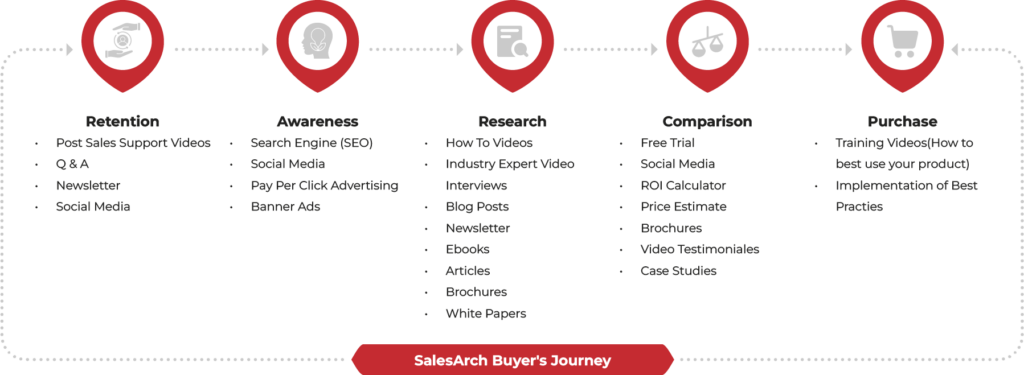Sales

Let our team develop your sales pipeline, so you can focus on what matters for you.
How SalesArch works in the different states of the buyer’s journey

The beginning of the cycle. Here is when the customer understands that it has a need, and begins to research the alternatives available. It’s also the stage where companies tend to put the most effort into their marketing. It is a combination of brand awareness and early-acquisition.
The first thing you should do is identify your audience. One of the most effective strategies is the creation of buyer personas – fictional representations of your ideal customer that includes their problems, goals and interests.
At this level, the content of your website must answer specific questions: “How to”, “When is”, “What is”, “Where can I”, “The best way to”, among others. The goal is to introduce your brand’s personality, inform buyers, and leave them wanting more. By publishing different types of content on your website and social media, you’ll establish your company as a credible source of information. Improving your organic search engine rankings (SEO) remains one of the most effective ways to build brand awareness and drive potential customers to your website.
As soon as potential customers become aware of your brand, they move to the next stage in the journey: consideration.


Once the research and evaluation of alternatives are done, the consumer arrives at the consideration stage. At this level, users have pre-selected some options, and it is here that personalisation comes into place. Highlighting the benefits of your brand vs competitors and how your products will solve their specific needs or problems, are critical to retain or lose those potential customers.
At this stage, buyers have not yet made a decision. In fact, they may consider your brand, but perhaps they are not ready to commit or buy. According to a Pardot study, 70% of buyers turn to Google at least two or three times while in the awareness and consideration stage. A robust content marketing strategy and the use of keywords is essential for your brand to appear among the first search results.
While optimising content for search engines (meta tags, landing pages, call-to-action, etc.), brands should also start to connect with potential customers through social media and also paid advertising. According to eConsultancy, 61% of consumers are influenced by peer reviews. Once customers are convinced they need to purchase a solution for their problems — whether your product or your competitors’ — they progress to the next stage: intent.
The stages of consideration and intent tend to overlap. However, logical, financial and even emotional factors have significant weight on the buyer’s decision to move forward and finally make a decision. Customers who reach the intent stage are ready to buy. Your job now is to persuade them to buy your product. Success here depends more on earning trust with potential customers than educating them.
For product pages, this includes everything from optimising the description and use of keywords to adding reviews and comments from other users. The optimisation of your website must have a solid promotional and social media strategy. Let your product speak for itself: highlight what your product can do that’s better than the rest, why your other customers love it, and why your brand is a sign of quality. Eventually, each customer will be ready to pull the purchase trigger and then progress to the next stage.


Finally, the time has come to make a decision. This is the penultimate stage in the purchase cycle and the brand must continue reinforcing the message. For instance, the content must be even more specific to highlight the value proposition. This may be your last chance to transform a potential customer into a buyer. By this stage, it’s crucial that your website and email content addresses the concerns of decision-stage buyers with appropriate, more targeted messages. This means optimising your website’s navigation and calls-to-action and your email content to direct them toward relevant bottom-of-the-funnel results.
The last stage of the cycle is purchasing. Completing a transaction seems easy, but it is a process that involves multiple variables. Even at this level, the job is not complete. The relationship with the consumer is just beginning. The brand must be with this user throughout the process, making the shopping experience simple, fast and effective. The shopping cart abandonment rate is 70% for online retailers and e-commerce. This means that even at the purchase stage, the consumer may consider abandoning the process entirely. At this stage, optimising the checkout page is essential (to find out how to get the best results, visit this blog post), as well as showing product recommendations and cross and up-selling to increase the order value.


This stage can look a little different, depending on what you’re selling. If the product you sell is perishable or consumable, your customer will most likely be back soon for a reorder. Likewise, if you’re a subscription company, your continuous purchase point will be when a customer’s billing cycle is charged again. This stage can (and ideally will) repeat indefinitely, so it’s where companies frequently find the most significant opportunities for increasing revenue.
SalesArch Sales Development Strategy
SalesArch is a company that takes the country and market risk, investment risk, compliance risk, legal and personnel risks required for success, especially cyber security, information technology companies that want to take a place in the Turkish market, and enables their customers to take the fastest way to the market they need.